[English] 日本語
 Yorodumi
Yorodumi- PDB-3vcd: Computationally Designed Self-assembling Octahedral Cage protein,... -
+ Open data
Open data
- Basic information
Basic information
| Entry | Database: PDB / ID: 3vcd | ||||||
|---|---|---|---|---|---|---|---|
| Title | Computationally Designed Self-assembling Octahedral Cage protein, O333, Crystallized in space group R32 | ||||||
 Components Components | Propanediol utilization polyhedral body protein PduT | ||||||
 Keywords Keywords |  ELECTRON TRANSPORT / self assembling octahedral cage design ELECTRON TRANSPORT / self assembling octahedral cage design | ||||||
| Function / homology |  Function and homology information Function and homology informationpropanediol degradation polyhedral organelle / propanediol catabolic process / 4 iron, 4 sulfur cluster binding /  metal ion binding metal ion bindingSimilarity search - Function | ||||||
| Biological species |   Salmonella enterica (bacteria) Salmonella enterica (bacteria) | ||||||
| Method |  X-RAY DIFFRACTION / X-RAY DIFFRACTION /  SYNCHROTRON / SYNCHROTRON /  MOLECULAR REPLACEMENT / MOLECULAR REPLACEMENT /  molecular replacement / Resolution: 2.35 Å molecular replacement / Resolution: 2.35 Å | ||||||
 Authors Authors | Sawaya, M.R. / King, N.P. / Sheffler, W. / Baker, D. / Yeates, T.O. | ||||||
 Citation Citation |  Journal: Science / Year: 2012 Journal: Science / Year: 2012Title: Computational design of self-assembling protein nanomaterials with atomic level accuracy. Authors: Neil P King / William Sheffler / Michael R Sawaya / Breanna S Vollmar / John P Sumida / Ingemar André / Tamir Gonen / Todd O Yeates / David Baker /  Abstract: We describe a general computational method for designing proteins that self-assemble to a desired symmetric architecture. Protein building blocks are docked together symmetrically to identify ...We describe a general computational method for designing proteins that self-assemble to a desired symmetric architecture. Protein building blocks are docked together symmetrically to identify complementary packing arrangements, and low-energy protein-protein interfaces are then designed between the building blocks in order to drive self-assembly. We used trimeric protein building blocks to design a 24-subunit, 13-nm diameter complex with octahedral symmetry and a 12-subunit, 11-nm diameter complex with tetrahedral symmetry. The designed proteins assembled to the desired oligomeric states in solution, and the crystal structures of the complexes revealed that the resulting materials closely match the design models. The method can be used to design a wide variety of self-assembling protein nanomaterials. | ||||||
| History |
|
- Structure visualization
Structure visualization
| Structure viewer | Molecule:  Molmil Molmil Jmol/JSmol Jmol/JSmol |
|---|
- Downloads & links
Downloads & links
- Download
Download
| PDBx/mmCIF format |  3vcd.cif.gz 3vcd.cif.gz | 542 KB | Display |  PDBx/mmCIF format PDBx/mmCIF format |
|---|---|---|---|---|
| PDB format |  pdb3vcd.ent.gz pdb3vcd.ent.gz | 453.4 KB | Display |  PDB format PDB format |
| PDBx/mmJSON format |  3vcd.json.gz 3vcd.json.gz | Tree view |  PDBx/mmJSON format PDBx/mmJSON format | |
| Others |  Other downloads Other downloads |
-Validation report
| Arichive directory |  https://data.pdbj.org/pub/pdb/validation_reports/vc/3vcd https://data.pdbj.org/pub/pdb/validation_reports/vc/3vcd ftp://data.pdbj.org/pub/pdb/validation_reports/vc/3vcd ftp://data.pdbj.org/pub/pdb/validation_reports/vc/3vcd | HTTPS FTP |
|---|
-Related structure data
- Links
Links
- Assembly
Assembly
| Deposited unit | 
| ||||||||
|---|---|---|---|---|---|---|---|---|---|
| 1 | 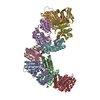
| ||||||||
| Unit cell |
|
- Components
Components
| #1: Protein | Mass: 19964.084 Da / Num. of mol.: 8 Mutation: K15A, C38S, M67L, N148A, N149L, E156S, E160A, K161Y, R167A, V169L Source method: isolated from a genetically manipulated source Source: (gene. exp.)   Salmonella enterica (bacteria) / Gene: PduT / Plasmid: pET29b / Production host: Salmonella enterica (bacteria) / Gene: PduT / Plasmid: pET29b / Production host:   Escherichia coli (E. coli) / Strain (production host): BL21(DE3) / References: UniProt: E7V033, UniProt: Q9XDM8*PLUS Escherichia coli (E. coli) / Strain (production host): BL21(DE3) / References: UniProt: E7V033, UniProt: Q9XDM8*PLUS#2: Chemical | ChemComp-SO4 /  Sulfate Sulfate#3: Chemical | ChemComp-CL / |  Chloride Chloride#4: Water | ChemComp-HOH / |  Water Water |
|---|
-Experimental details
-Experiment
| Experiment | Method:  X-RAY DIFFRACTION / Number of used crystals: 1 X-RAY DIFFRACTION / Number of used crystals: 1 |
|---|
- Sample preparation
Sample preparation
| Crystal | Density Matthews: 3.21 Å3/Da / Density % sol: 61.71 % |
|---|---|
Crystal grow | Temperature: 298 K / Method: vapor diffusion, hanging drop / pH: 4.5 Details: 0.8M sodium phosphate monobasic, 1.2M potassium phosphate dibasic, 0.1 M sodium acetate, pH 4.5, 10 mM L-proline, crystal soaked in 2M lithium sulfate as cryoprotectant, VAPOR DIFFUSION, ...Details: 0.8M sodium phosphate monobasic, 1.2M potassium phosphate dibasic, 0.1 M sodium acetate, pH 4.5, 10 mM L-proline, crystal soaked in 2M lithium sulfate as cryoprotectant, VAPOR DIFFUSION, HANGING DROP, temperature 298K |
-Data collection
| Diffraction | Mean temperature: 100 K | |||||||||||||||||||||||||||||||||||||||||||||||||||||||||||||||||||||||||||||
|---|---|---|---|---|---|---|---|---|---|---|---|---|---|---|---|---|---|---|---|---|---|---|---|---|---|---|---|---|---|---|---|---|---|---|---|---|---|---|---|---|---|---|---|---|---|---|---|---|---|---|---|---|---|---|---|---|---|---|---|---|---|---|---|---|---|---|---|---|---|---|---|---|---|---|---|---|---|---|
| Diffraction source | Source:  SYNCHROTRON / Site: SYNCHROTRON / Site:  APS APS  / Beamline: 24-ID-C / Wavelength: 0.9794 Å / Beamline: 24-ID-C / Wavelength: 0.9794 Å | |||||||||||||||||||||||||||||||||||||||||||||||||||||||||||||||||||||||||||||
| Detector | Type: ADSC QUANTUM 315 / Detector: CCD / Date: Oct 16, 2011 | |||||||||||||||||||||||||||||||||||||||||||||||||||||||||||||||||||||||||||||
| Radiation | Monochromator: Cryo-Cooled Si(111) double crystal / Protocol: SINGLE WAVELENGTH / Monochromatic (M) / Laue (L): M / Scattering type: x-ray | |||||||||||||||||||||||||||||||||||||||||||||||||||||||||||||||||||||||||||||
| Radiation wavelength | Wavelength : 0.9794 Å / Relative weight: 1 : 0.9794 Å / Relative weight: 1 | |||||||||||||||||||||||||||||||||||||||||||||||||||||||||||||||||||||||||||||
| Reflection | Resolution: 2.35→100 Å / Num. all: 81734 / Num. obs: 81734 / % possible obs: 95 % / Observed criterion σ(I): -3 / Redundancy: 6.9 % / Biso Wilson estimate: 72.1 Å2 / Rmerge(I) obs: 0.066 / Χ2: 1 / Net I/σ(I): 14.4 | |||||||||||||||||||||||||||||||||||||||||||||||||||||||||||||||||||||||||||||
| Reflection shell |
|
-Phasing
Phasing | Method:  molecular replacement molecular replacement | |||||||||
|---|---|---|---|---|---|---|---|---|---|---|
| Phasing MR | Rfactor: 45.8 / Model details: Phaser MODE: MR_AUTO
|
- Processing
Processing
| Software |
| |||||||||||||||||||||||||||||||||||||||||||||||||||||||||||||||||||||||||||||||||||||||||||||||||||||||||||||||||||||||||||||||||||||||||||||||||||||||||||||||||||||||||||||||||||||||||||||||||||||||||||||||||||||||||||||||||
|---|---|---|---|---|---|---|---|---|---|---|---|---|---|---|---|---|---|---|---|---|---|---|---|---|---|---|---|---|---|---|---|---|---|---|---|---|---|---|---|---|---|---|---|---|---|---|---|---|---|---|---|---|---|---|---|---|---|---|---|---|---|---|---|---|---|---|---|---|---|---|---|---|---|---|---|---|---|---|---|---|---|---|---|---|---|---|---|---|---|---|---|---|---|---|---|---|---|---|---|---|---|---|---|---|---|---|---|---|---|---|---|---|---|---|---|---|---|---|---|---|---|---|---|---|---|---|---|---|---|---|---|---|---|---|---|---|---|---|---|---|---|---|---|---|---|---|---|---|---|---|---|---|---|---|---|---|---|---|---|---|---|---|---|---|---|---|---|---|---|---|---|---|---|---|---|---|---|---|---|---|---|---|---|---|---|---|---|---|---|---|---|---|---|---|---|---|---|---|---|---|---|---|---|---|---|---|---|---|---|---|---|---|---|---|---|---|---|---|---|---|---|---|---|---|---|---|
| Refinement | Method to determine structure : :  MOLECULAR REPLACEMENT / Resolution: 2.35→81.74 Å / Cor.coef. Fo:Fc: 0.9617 / Cor.coef. Fo:Fc free: 0.9446 / Occupancy max: 1 / Occupancy min: 0.5 / SU R Cruickshank DPI: 0.232 / Cross valid method: THROUGHOUT / σ(F): 0 / Stereochemistry target values: Engh & Huber MOLECULAR REPLACEMENT / Resolution: 2.35→81.74 Å / Cor.coef. Fo:Fc: 0.9617 / Cor.coef. Fo:Fc free: 0.9446 / Occupancy max: 1 / Occupancy min: 0.5 / SU R Cruickshank DPI: 0.232 / Cross valid method: THROUGHOUT / σ(F): 0 / Stereochemistry target values: Engh & Huber
| |||||||||||||||||||||||||||||||||||||||||||||||||||||||||||||||||||||||||||||||||||||||||||||||||||||||||||||||||||||||||||||||||||||||||||||||||||||||||||||||||||||||||||||||||||||||||||||||||||||||||||||||||||||||||||||||||
| Displacement parameters | Biso max: 179.18 Å2 / Biso mean: 70.1529 Å2 / Biso min: 36.24 Å2
| |||||||||||||||||||||||||||||||||||||||||||||||||||||||||||||||||||||||||||||||||||||||||||||||||||||||||||||||||||||||||||||||||||||||||||||||||||||||||||||||||||||||||||||||||||||||||||||||||||||||||||||||||||||||||||||||||
| Refine analyze | Luzzati coordinate error obs: 0.339 Å | |||||||||||||||||||||||||||||||||||||||||||||||||||||||||||||||||||||||||||||||||||||||||||||||||||||||||||||||||||||||||||||||||||||||||||||||||||||||||||||||||||||||||||||||||||||||||||||||||||||||||||||||||||||||||||||||||
| Refinement step | Cycle: LAST / Resolution: 2.35→81.74 Å
| |||||||||||||||||||||||||||||||||||||||||||||||||||||||||||||||||||||||||||||||||||||||||||||||||||||||||||||||||||||||||||||||||||||||||||||||||||||||||||||||||||||||||||||||||||||||||||||||||||||||||||||||||||||||||||||||||
| Refine LS restraints |
| |||||||||||||||||||||||||||||||||||||||||||||||||||||||||||||||||||||||||||||||||||||||||||||||||||||||||||||||||||||||||||||||||||||||||||||||||||||||||||||||||||||||||||||||||||||||||||||||||||||||||||||||||||||||||||||||||
| LS refinement shell | Resolution: 2.35→2.41 Å / Total num. of bins used: 20
| |||||||||||||||||||||||||||||||||||||||||||||||||||||||||||||||||||||||||||||||||||||||||||||||||||||||||||||||||||||||||||||||||||||||||||||||||||||||||||||||||||||||||||||||||||||||||||||||||||||||||||||||||||||||||||||||||
| Refinement TLS params. | Method: refined / Refine-ID: X-RAY DIFFRACTION
| |||||||||||||||||||||||||||||||||||||||||||||||||||||||||||||||||||||||||||||||||||||||||||||||||||||||||||||||||||||||||||||||||||||||||||||||||||||||||||||||||||||||||||||||||||||||||||||||||||||||||||||||||||||||||||||||||
| Refinement TLS group |
|
 Movie
Movie Controller
Controller



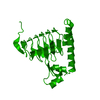
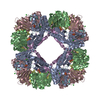
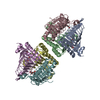

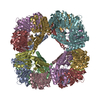
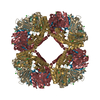
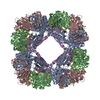



 PDBj
PDBj






